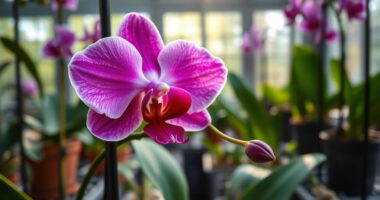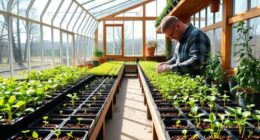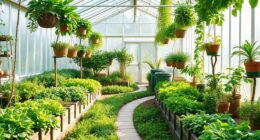Growing herbs indoors all year round is a smart way to enjoy fresh flavors anytime. The best herbs for your greenhouse include basil, parsley, thyme, and mint, as they thrive in controlled environments and grow quickly. By maintaining the right temperature, humidity, and lighting, you can guarantee healthy, continuous yields. Plus, proper preservation methods keep herbs fresh longer. Keep going to discover tips for creating the perfect indoor herb garden year-round.
Key Takeaways
- Choose herbs like basil, parsley, thyme, and mint that thrive in controlled indoor environments year-round.
- Maintain optimal greenhouse conditions—light, temperature, and humidity—for consistent herb growth regardless of season.
- Use grow lights and heating systems to mimic natural sunlight and extend herb cultivation into winter months.
- Regularly prune and water herbs to promote healthy growth and maximize yield throughout the year.
- Preserve excess herbs through drying, freezing, or infusing oils to ensure a continuous supply beyond the growing season.

Herbs can be a year-round delight with the right planning and care. When you set up a greenhouse, you access the potential to grow a variety of herbs regardless of the season. One of the keys is choosing the right indoor herb varieties that thrive in controlled environments. Basil, parsley, thyme, and mint are excellent options because they grow quickly and adapt well to greenhouse conditions. By cultivating these herbs indoors, you guarantee a continuous supply of fresh flavorings for your cooking, teas, or medicinal uses. Plus, indoor herbs tend to be less susceptible to pests and harsh weather, giving you more consistent yields. Regularly monitoring and adjusting drivetrain components can help ensure your equipment remains in top condition, much like maintaining healthy herbs in your greenhouse.
Growing herbs indoors ensures a continuous, pest-free supply of fresh flavors year-round.
To maximize your herb harvest throughout the year, you should also pay attention to seasonal herb preservation. During peak growing times, when your herbs are lush and abundant, it’s smart to harvest and preserve them for later use. Freezing herbs in ice cube trays, drying sprigs for seasoning, or making herb-infused oils are practical ways to extend their flavor beyond their growing season. This approach not only prevents waste but also keeps your kitchen stocked with fresh-tasting herbs even when they’re not in season outside. Preserving herbs also allows you to experiment with different flavors and recipes, making your culinary creations more vibrant and diverse.
Growing herbs in a greenhouse gives you control over factors like temperature, humidity, and light, which are essential for maintaining healthy indoor herb varieties. You can set up grow lights and heating systems to mimic ideal outdoor conditions, guaranteeing your herbs stay productive year-round. This control means you can start herbs early in spring or continue growing them through winter, bypassing traditional planting seasons. Regular pruning and proper watering keep your plants healthy and productive, while rotating different herbs ensures a steady supply of fresh greens for your kitchen.
Storing herbs properly helps maintain their aroma and potency, whether you’re drying, freezing, or preserving them in oils. Keep dried herbs in airtight containers away from sunlight, and freeze chopped herbs in small portions for quick use. By practicing seasonal herb preservation techniques, you make the most of your greenhouse’s productivity. With dedication and proper care, you can enjoy an endless supply of fresh herbs, transforming your cooking and herbal remedies into a year-round experience. Your greenhouse becomes not just a garden, but a reliable source of flavor, health, and freshness, no matter the season outside.
Frequently Asked Questions
What Are the Easiest Herbs for Beginners to Grow Indoors?
If you’re new to indoor herb basics, start with easy herbs like basil, mint, parsley, chives, and oregano. These thrive with minimal fuss, making them perfect for beginner gardening tips. Keep your herbs in bright, indirect light and water when the topsoil feels dry. Regular harvesting encourages growth, and don’t forget good drainage. With patience and care, you’ll enjoy fresh herbs year-round, boosting your confidence in indoor gardening.
How Do I Prevent Pests and Diseases in My Greenhouse Herbs?
To prevent pests and diseases in your greenhouse herbs, start with companion planting—pair herbs with plants that naturally repel pests. Keep your greenhouse clean and well-ventilated, and remove any diseased or dead leaves promptly. Use organic pest control methods like neem oil or insecticidal soap, avoiding harsh chemicals. Regularly inspect your herbs for signs of trouble, and act quickly to maintain healthy, thriving plants year-round.
What Soil Type Is Best for Year-Round Herb Cultivation?
Think of your soil as the foundation of a thriving garden—choose wisely. You should use well-draining, loamy soil with a balanced pH around 6.0 to 7.0. Incorporate organic soil amendments like compost to enrich nutrients and maintain pH balance. This creates a nurturing environment, ensuring your herbs flourish year-round. Proper soil sets the stage for healthy growth, giving your herbs the best chance to thrive indoors.
How Often Should I Harvest Herbs From My Greenhouse?
You should harvest herbs from your greenhouse regularly, typically every few weeks, to encourage continuous growth. Pay attention to harvest timing—wait until the herbs reach full maturity for the best flavor and potency. For most herbs, like basil or cilantro, harvest when they’re lush and healthy, usually just before flowering. Frequent harvesting promotes new growth, ensuring you get fresh, flavorful herbs throughout the year.
Can I Grow Herbs Indoors Without Natural Sunlight?
Yes, you can grow herbs indoors without natural sunlight by using artificial lighting. Make sure you select full-spectrum grow lights that mimic sunlight to support healthy growth. Additionally, maintain proper humidity control to prevent mold and keep your herbs thriving. Keep lights on for about 12-16 hours daily, and monitor humidity levels closely. With these methods, you’ll successfully grow fresh herbs indoors year-round, regardless of outside sunlight.
Conclusion
Growing herbs in your greenhouse is like tending a secret garden that rewards you year-round. I once watched a friend harvest fresh basil in December, proving that with a little care, your green thumb can defy the seasons. Just like nurturing a delicate seed into a thriving plant, your dedication turns your greenhouse into a perpetual oasis of fresh herbs. So, keep experimenting and enjoy the bounty—your garden’s magic is just a greenhouse away.








